3 Top Low-Temp Lithium Battery Breakthroughs
Table of Contents
Introduction to Low Temperature Lithium Battery Needs
As technology rapidly advances, the demand for low-temperature and ultra-low-temperature lithium batteries is increasingly critical in harsh environments such as high-altitude plateaus, deep oceans, polar regions, and extreme cold areas like outer space. Traditional lithium batteries are inadequate for energy storage and release in these severe temperature conditions.
The phasing out of subsidies for new energy vehicles and the accelerated construction of 5G base station storage by major telecom operators have significantly boosted the demand for low-temperature, cost-effective lithium-ion batteries. In 2021, domestic power battery installations reached 159.6 GWh. However, in northern regions with extreme winter conditions, the driving range of new energy vehicles is severely affected. Therefore, developing low temperature lithium batteries suitable for cold environments is crucial. For 5G base stations, low-temperature lithium iron phosphate batteries have gained industry recognition for their decisive competitive advantage, with the industry inevitably transitioning from lead-acid batteries to lithium iron phosphate batteries for communication signal tower backup power.
Temperature affects the mass transfer and charge transfer processes in lithium-ion batteries during charging and discharging. At low temperatures, the slowed kinetics of lithium ions is the most critical factor affecting their electrochemical performance. The ion conductivity of the electrolyte decreases, making the solvation/desolvation of lithium ions more challenging, significantly reducing the migration rate of lithium ions within the electrode active material and at the solid-liquid interface. These factors lead to severe degradation of battery performance. Additionally, the anode surface is prone to lithium plating and dendrite growth, causing battery failure and safety risks. To address these issues, researchers have improved low-temperature lithium battery performance by modifying cathode and anode materials, adjusting electrolyte components and solvent structures, and designing effective Battery Thermal Management Systems (BTMS), making them suitable for harsh low-temperature environments.

Current Research Status of Low-Temperature Lithium Batteries
1.1 Modification of Cathode Materials
At low temperatures, the primary reasons for the decreased capacity of cathode materials include lower electron conductivity, reduced lithium-ion migration rates, and slower lithium-ion intercalation/deintercalation kinetics compared to room temperature. Enhancing lithium-ion performance at low temperatures can be significantly achieved by modifying cathode materials through strategies such as bulk or surface ionic doping to improve lithium-ion migration rate or electron conductivity, employing carbon nanomaterials to form multidimensional conductive structures, modifying with ionic conductors to increase both electron and ionic conductivity, and optimizing crystal structure to shorten the internal diffusion distance of lithium ions and thereby enhance the kinetics of lithium-ion intercalation and deintercalation.
1.2 Modification of Anode Materials
At low temperatures, anode materials experience reduced lithium-ion migration rates, making lithium-ion desolvation more difficult, increasing electrochemical transfer impedance, and decreasing the lithium-ion intercalation capacity leading to electrode polarization. The unintercalated lithium is prone to plating on the anode, further exacerbating lithium dendrite growth, SEI film thickening, and electrolyte drying out, ultimately causing a decrease in the lithium-ion battery’s capacity and cyclic performance. Graphite is primarily used as an anode material, but high charging plateau and cut-off voltage materials like Li4Ti5O12 and hard carbon are also employed to avoid lithium plating at low temperatures. Researchers primarily improve the low-temperature performance of lithium-ion batteries by doping, preparing nano-composite electrodes (including adding nano-carbon materials, carbon-coating nano materials, and other nano-composite electrodes), modifying graphite electrodes, and developing new anode materials.
1.3 Electrolyte Composition and Solvent Structure Adjustment
The electrolyte impacts lithium-ion mobility and participates in forming the Solid Electrolyte Interface (SEI) film, crucial to a battery’s electrochemical performance at low temperatures. Viscosity and solvation degree significantly influence lithium-ion mobility. Electrolytes in low-temperature lithium batteries should possess high ionic conductivity and low viscosity while maintaining necessary low-temperature stability. Cyclic carbonates like ethylene carbonate (EC) are advantageous for forming a stable SEI layer but have higher viscosity and melting points. Adding linear carbonates, esters, or ethers with lower viscosity and melting points through a co-solvent strategy helps maintain the electrolyte in a liquid state at low temperatures. However, it’s crucial to balance the reduced flash point of electrolytes after adding low-viscosity linear carbonates to ensure thermal stability. High-concentration electrolytes are favored despite lower ionic conductivity and higher viscosity, due to their lower charge transfer impedance, better rate performance, and enhanced low-temperature capabilities.
2. Research and Development of New Low-Temperature Lithium Battery Systems
While some progress has been made in the low-temperature performance of lithium-ion batteries, innovative research into new low-temperature lithium battery systems has been relatively scarce. Superionic conductors, known for their excellent ionic conductivity, can effectively improve the lithium-ion migration rate, offering fresh perspectives for enhancing the low-temperature performance of lithium batteries.
In 2011, the Kamaya research group in Japan developed a new type of inorganic sulfide superionic conductor material, Li10GeP2S12, which boasts an ultra-high conductivity. It has a decomposition voltage of over 5V and a lithium-ion conductivity of 12 mS/cm at room temperature (27°C), rivaling and even surpassing traditional organic liquid electrolytes. Remarkably, even at -40°C, its ionic conductivity can reach 0.41 mS/cm, exhibiting the best conductivity among various superionic conductors, particularly in low-temperature conditions where its performance far exceeds that of organic electrolytes.

